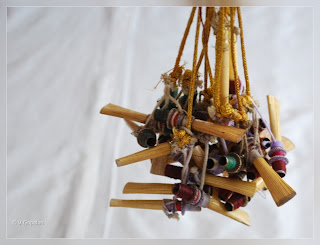In India the nadaswaram is considered to be very auspicious, and it is the key instrument which is played in almost all Hindu marriages and temples in South India. It is part of the family of instruments known as a Mangala Vadya (mangala means auspicious, vadya means instrument). The instrument is usually played in pairs, and accompanied by a pair of drums called thavil.
The nadaswaram contains three parts namely, kuzhal, thimiru, and anasu. Traditionally the body of the nadaswaram is made out of a tree called aacha.
It is a double reed instrument with a conical bore which gradually enlarges toward the lower end. It is usually made of a type of ebony. The top portion has a metal staple (called "Mel Anaichu") into which is inserted a small metallic cylinder (called "Kendai") which carries the mouthpiece made of reed. Besides spare reeds, a small ivory or horn needle is attached to the Nadswaram. This needle is used to clear the mouthpiece of saliva particles and allows the free passage of air. A metallic bell (called "Keezh anaichu") decorates the bottom.
The Nadaswaram has seven finger-holes. There are five additional holes drilled at the bottom which are used as controllers. The Nadaswaram has a range of two and a half octaves like the flute. The system of fingering is similar to that of the flute. But unlike the flute, where semi and quarter tones are produced by the partial opening and closing of the finger holes, in the Nadaswaram they are produced by adjusting the pressure and strength of the air-flow into the pipe. Hence it is a very exacting instrument. Also, due to its intense volume and strength it is basically an outdoor instrument and much more suited for open spaces than for closed indoor concert situations.






No comments:
Post a Comment